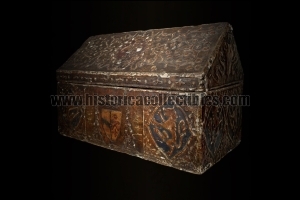Cassina Florentine belonged to Bishop Jacopo Nacchianti, circa 1550
Wooden casket or Cassina, rectangular in shape and sloping roof lid, modeled and decorated in low relief with painted and gilded tablet, made for Jacopo Nacchianti, Bishop of Chioggia from 1544 to 1569.
The belonging of Cassina to the high Dominican Prelate is evident from the coat of arms placed in the center of the front facade where there is the coat of arms attributable to him composed as follows:
"Saturn" headdress, from which six tassels hang on each side (episcopal emblem);
From the bipartite Gothic triangular shield with a gold background, typical of ecclesiastical heraldry, bearing on one side a black band facing downwards, which refers to a part of the Dominican dress (black cape and cloak) indicating renunciation and penance;
An eight-pointed polar star, symbol of predestination and personal sign of Saint Dominic since it is said that, on the day of his baptism, his mother saw a bright star shining on the saint's forehead.
Furthermore, two branches of Lion in decusse are correlated to "fortitude" and "valour" while, placed under them, the Florentine Lily is depicted whose Christian symbolism sees in its three stylized petals, an allusion to the "Divine Trinity" and , in the horizontal base, the figure of Mary.
Two "Horse's Head" shields are present at the two ends of the sloping sides of the roof on which the paintings of the Cross of St. George are highlighted on one side, while on the other a red Eagle, with a golden lily in head, holds a green dragon in its claws: this is the figurative image of the ancient insignia of the Order of the Guelph Party (supporters of the papacy) of which Nacchianti was a confrere.
Followed by six rampant lions, each within an ornamental frame and facing frontally, surround three facades of the Cassina to define the coat of arms of Chioggia.
Finally, to complete the Cassina, in the center of each side of the sloping roof, two large Florentine lilies stand out inside a laurel wreath, commemorating the victory of the Guelphs over the Ghibellines in the battle of the Piana di Campaldino (Poppi - province of Arezzo ) fought between the two armies on 11 June 1289.
The rarity of the object in question is indisputable as is its state of conservation which presents decorations and ornaments fully attributable and coherent to the Renaissance period, placing its creation precisely within the first half of the 16th century.
JACOPO NACCHIANTI (Nacchiante, Naclantus, de Naclantibus), John the Baptist (Jacopo in religion). – He was born in Florence on 15 October 1502, to the notary Andrea di Cristofano and Dianora di Bardo Gherardini.
The Nacchianti family had many notaries. With clear Savonarola sympathies, they had close relationships with the Ospedale degli Innocenti and with the Confraternity of S. Zanobi. In the will drawn up on 19 February 1510, shortly before his death, Andrea appointed his son as universal heir, indicating three guardians; but he supposedly also left him many debts. In fact, after the death of his father (9 March 1510), Nacchianti was entrusted to the Innocenti hospital. On 22 February 1518 he made a will, leaving his assets to the Innocenti, in preparation for his entry into the convent of S. Marco. He took the habit of a Dominican novice on March 7, taking the monastic name of Jacopo, and made his solemn profession the following year. In 1528, having recognized his intellectual gifts, he went to Bologna to study theology at the University, where he formed relationships with Michele Ghislieri, the future cardinal and Pope Pius V. Six years later his career within the order with a series of positions in various convents in central Italy: in 1534, in Perugia, he assumed the post of magisterstudentium; he was then elected prior at S. Caterina in Pisa on 15 October 1536 and at Lucca in May 1537. The following year, he was called to L'Aquila to replace the Lenten preacher. Subsequently, he held a professorship at the Perugia studio for the three-year period 1539-41. From here he moved to the convent of S. Maria sopra Minerva in Rome to continue teaching theology. In 1541 his name appears among the definers of the Roman provincial chapter.

